


Canons of San Lorenzo
An imperial privilege of 1163 (see below) refers to an earlier one granted to the canons of San Lorenzo by the Emperor Henry II (1014-24). The earliest surviving document referring to them dates to the time of a bishop called Andrea and a pope called Benedict: these are almost certainly Bishop Andrea (1033-6) and Pope Benedict IX (1033-44). This document exhorted them to live as clerics, holding property only in common ownership.
The first of many documented disputes between canons and their bishop occurred in 1036, when two imperial legates (Adalberto and Everardo) of the Emperor Conrad II arbitrated in a dispute between Bishop Andrea and the Archpriest Leone Bovo. As a result, Bishop Andrea recognised the canons’ ownership of all the properties that had been the subject of dispute between them in the previous three years. (The arbitration took place “erga ecclesia vocabulo Sancti Stefano” (near the church of Santo Stefano). The church in question was probably Santo Stefano Castellare, which was later documented as a parish church owned by the canons.
In 1163, during his war with Pope Alexander III, the Emperor Frederick I took Bishop John IV and the Canons of San Lorenzo under imperial protection and confirmed all of their possessions. The surviving copy of this privilege (which is the one referred to in the previous paragraph) does not mention the relevant pope, but this was presumably the anti-pope Victor IV. Local tradition has it that a subsequent anti-pope, Callistus III (1168-77) consecrated the high altar of the Duomo. However, Alexander III also confirmed the possessions of the canons’ possessions in 1169. It is likely that this was a period of schism within the episcopal authorities of Perugia: apart from this mention of John IV, no bishop is documented between 1160 and 1179.
Financial considerations often gave rise disputes between the canons on the one hand and the bishop on the other throughout the 11th and 12th centuries. In one notable accord, for example, which was reached in 1193, Bishop Viviano granted the donations received on the feast of St Herculanus to the canons, while retaining the right to nominate the custodian of the relics. One of the first acts of Pope Innocent III after his accession in 1198 was to reform the canonical community at San Lorenzo. This reiterated that the canons should relinquish their individual assets (although they continued to own their considerable property in common) and should live in a semi-monastic community.
Innocent III supported the canons in 1207, when the Commune seized some of their property to build the Palazzo del Podestà. However, the canons eventually decided to accept the situation in return for compensation in 1208. This did not prevent further papal decisions in favour of the canons, all of which the Commune ignored. There was further controversy when Palazzo del Podestà was extended in 1282-92 to adjoin and probably invade Palazzo dei Canonici itself. The final phase of the dispute, which related to the ownership of the church of San Severo, was resolved in 1319 in favour of the Commune: this church was subsequently deconsecrated and incorporated into Palazzo dei Priori.
Pope Benedict XI stayed in the Palazzo dei Canonici during his stay in Perugia in 1304. He transferred the ownership of the church of Santo Stefano del Castellare from the canons to the Dominicans and granted plenary indulgences (issued from Palazzo dei Canonici) to those celebrating there on the feast of St Stephen (see the miniature below).
In 1512 Pope Julius II decreed that the canons should revert to the secular state. The new chapter had an Archpriest, an Archdeacon and fifteen canons drawn largely from the Perugian aristocracy. This arrangement persisted until the 19th century, when the Jesuit-educated Cardinal Gioacchino Pecci, Archbishop of Perugia, decreed that the canons should be priests drawn from the graduates of the seminary.
Ancient Palazzo dei Canonici
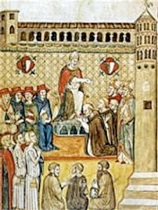
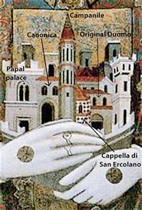
Miniature (1343) detail of a panel (ca. 1330) by the
in ms. 975 Maestro dei Dossali di Montelabate,
Biblioteca Augusta Galleria Nazionale
The canons' first palace was built next to the old Duomo at an early date in a fortified structure known as the Castello di San Lorenzo. Part of this palace seems to have been incorporated into the adjacent Palazzo del Podestà in 1284 to form a new palace for Pope Martin IV. (The excavated foundations of this palace can be seen inside the Museo Capitolare - see below). Martin IV died here in 1285, as did Pope Benedict XI in 1301.
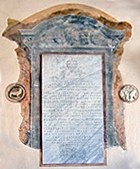
-
✴in 1216, after the death in Perugia of Pope Innocent III;
-
✴in 1265, after the death of Pope Urban IV;
-
✴in 1285, after the death in Perugia of Pope Martin IV;
-
✴in 1294, when the conclave following the death of Pope Nicholas IV was forced to abandon Rome; and
-
✴in 1304-5, after the death in Perugia of Benedict XI (above).
This palace burned down in 1329:
-
✴The miniature on the right above, which shows Benedict XI conceding a perpetual indulgence in relation to the church of Santo Stefano del Castellare (above), probably depicts the ancient palace to the left of the old campanile.
-
✴The panel on the right above, which shows the episcopal complex in the hands of St Herculanus, probably depicts the palace after its rebuilding.
Present Palazzo dei Canonici
The present palace was begun in the late 15th century and continued into the 18th century. It extends to the west and north of the Duomo, bounded by Via Maestà delle Volte, Piazza Cavallotti and Via Cantine (see below). The part of the palace facing Piazza IV Novembre (to the left of the Loggia di Braccio) was adapted as the Palazzo del Seminario in 1564.

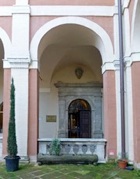
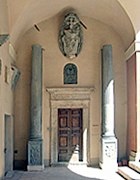
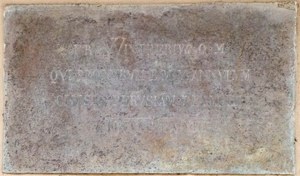
This marble inscription in the wall to the left of this entrance records that Fra Wintherius (in Italian, Winterio) brought the Virgin’s wedding ring to Perugia in 1473. It is now in the Cappella del Sant' Anello in the Duomo.
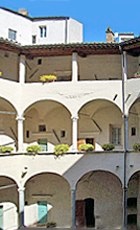
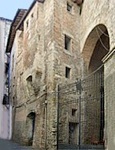
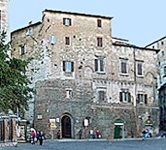
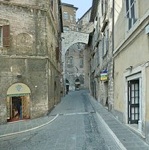
Via delle Cantine Piazza Cavallotti Via Maestà delle Volte
The portal at the far end opens into Piazza Cavallotti, with a view back of the curtain wall of the palace. In Walk I, you see the entire exterior of the complex:
-
✴Via delle Cantine, to the left as you look back at the palace from the piazza, is named for the cellars of the palace. It seems that wine from these cellars had to be used in 1315 to put out a fire that threatened the palace. The buildings at number 6 - 8 on the left have the arms of the canons of San Lorenzo on their portals and the date of their completion, 1745.
-
✴Via Maestà delle Volte to the right [takes you through the extraordinary vestiges of the Castello di San Lorenzo].

